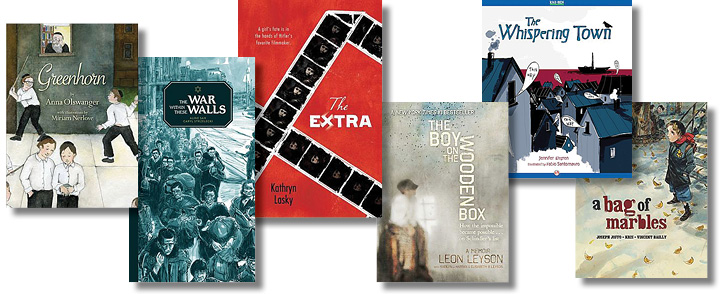By Rita Berman Frischer, Special to the Jewish Sound
The Holocaust is a difficult topic for parents or teachers to introduce to children so they often turn to books for help. At first, such resources were rare and indirect. For example, “Terrible Things” in 1980, a picture book allegory, emphasized the need for us to protect each other without defining the threat. Eventually, over 100 picture books followed, some, like “Promise of a New Spring” or “The Number on My Grandfather’s Arm,” provided information without horror; others were better for reading aloud to older students as discussion starters. Age appropriateness was usually determined by the images included, whether graphically explicit or verbally shocking to the imagination.
Times change. Now children’s books on many topics, especially fantasy, are being snatched up by filmmakers, which make their most stunning images in the flesh. Scenes previously only imagined can be seen on enormous screens. No wonder these recent books on the Holocaust seem so visually focused.
“A Bag of Marbles” by Joseph Joffo, adapted by Kris. Illustrated by Vincent Bailly. Translated by Edward Gauvin. This striking graphic novel, based on Joffo’s life story, tracks the hair-raising escape of two brothers from occupied Paris to their older brothers in the free zone. They hide their Jewishness, face danger, and occasionally receive unexpected help. This well-realized portrait of a childhood cut short was first published in French in 1973, translated widely, and became a film in 1975.
“The Boy on the Wooden Box: How the Impossible Became Possible…on Schindler’s List” by Leon Leyson (Atheneum Books for Young Readers) is a vividly descriptive memoir of a young boy who survived because of luck and Oskar Schindler. Schindler’s determination and ” list” saved many lives and Leyson’s contact with other Schindlerjuden didn’t end with the war but continued in California. There, fellow survivor Leopold Page told some stories to writer Thomas Keneally, whose resultant 1982 book became the inspiration for Steven Spielberg’s unforgettable 1993 film, “Schindler’s List.”
“Greenhorn” by Anna Olswanger, with illustrations by Miriam Nerlove (NewSouth Books), is also based on a true story of strength and survival but set post-war in a yeshiva in Brooklyn in 1946. A boy survivor from Poland arrives there, clutching a mysteriously precious box. An American-born classmate, whose stutter also makes him an outsider, becomes a friend and their bond leads to both of them realizing seemingly impossible dreams. The language, history and cultural setting are right on and the images are so cinematic that many people, moved by this small, powerful book, have committed to financing the Greenhorn Film Project through Indiegogo. Donations are still welcome through pre-production. Shooting begins in May. For more info visit Olswanger’s website or contact Tom Whitus of Silver Hills Pictures, LLC.
Kathryn Lasky has written about Jews, and well, but her recent, specifically film-related book “The Extra” (Candlewick Press) calls attention to the Romani, also favorite victims of Hitler’s purification program. Lilo, who looks Spanish, is among those hand-picked from a labor camp to act as extras in a new film planned by Leni Riefenstahl, Hitler’s favorite filmmaker. When the cameras roll, they dance and sing, providing background for a Spanish folk opera in which Leni herself stars. But they sleep locked in a barn, starving and in terror of displeasing the volatile and sometimes vicious Riefenstahl. Lilo’s character is based loosely on Anna Blach, a real Roma girl from Vienna. Disproving her claims to have protected them, evidence shows that most of Riefenstahl’s gypsy extras were sent to death in Auschwitz when no longer needed. The film underway in this story, “Tiefland,” wasn’t released until 1953.
To better understand Leni’s status and importance to Hitler, I sought out and watched, with much discomfort, “Triumph of the Will,” her 1934 filming of the Nazi Party rally in Nuremberg, one of the most controversial films ever made and a masterpiece of Goebbels propaganda for the Nazi regime. After the war, it was banned in Germany and until she died in 2003, Riefenstahl, the filmmaker, was known primarily as a collaborator.
“The War Within These Walls” by Aline Sax, illustrated by Caryl Strzelecki and translated by Laura Watkinson (Eerdmans Books for Young Readers), is a strikingly illustrated novella set in the Warsaw Ghetto, combining stark but powerful drawings with simply stated truths about the dark facts of the time — cruelty and courage, violence and dignity — as seen through the eyes of the young narrator. The book’s size, layout, contrasts and pictures convey both hopelessness and hope.
Finally, here is a picture book for the younger child. On a dark cloudy night, Anett’s family fears the Jews they’re hiding won’t be able to find their way to the harbor where a fishing boat waits to take them to safety. No one can escort them there, not with soldiers watching every house. In “The Whispering Town” by Jennifer Elvgren, illustrated by Fabio Santomauro (Kar-Ben), young Anett, remembering how she safely brought food down the black basement steps, guided by the whispers of the hidden family, devises a way for all the villagers to demonstrate the helpful humanity still alive in Nazi-occupied Denmark in 1943.
The hunted and the hunters: Children’s books about the Holocaust

Related tags :